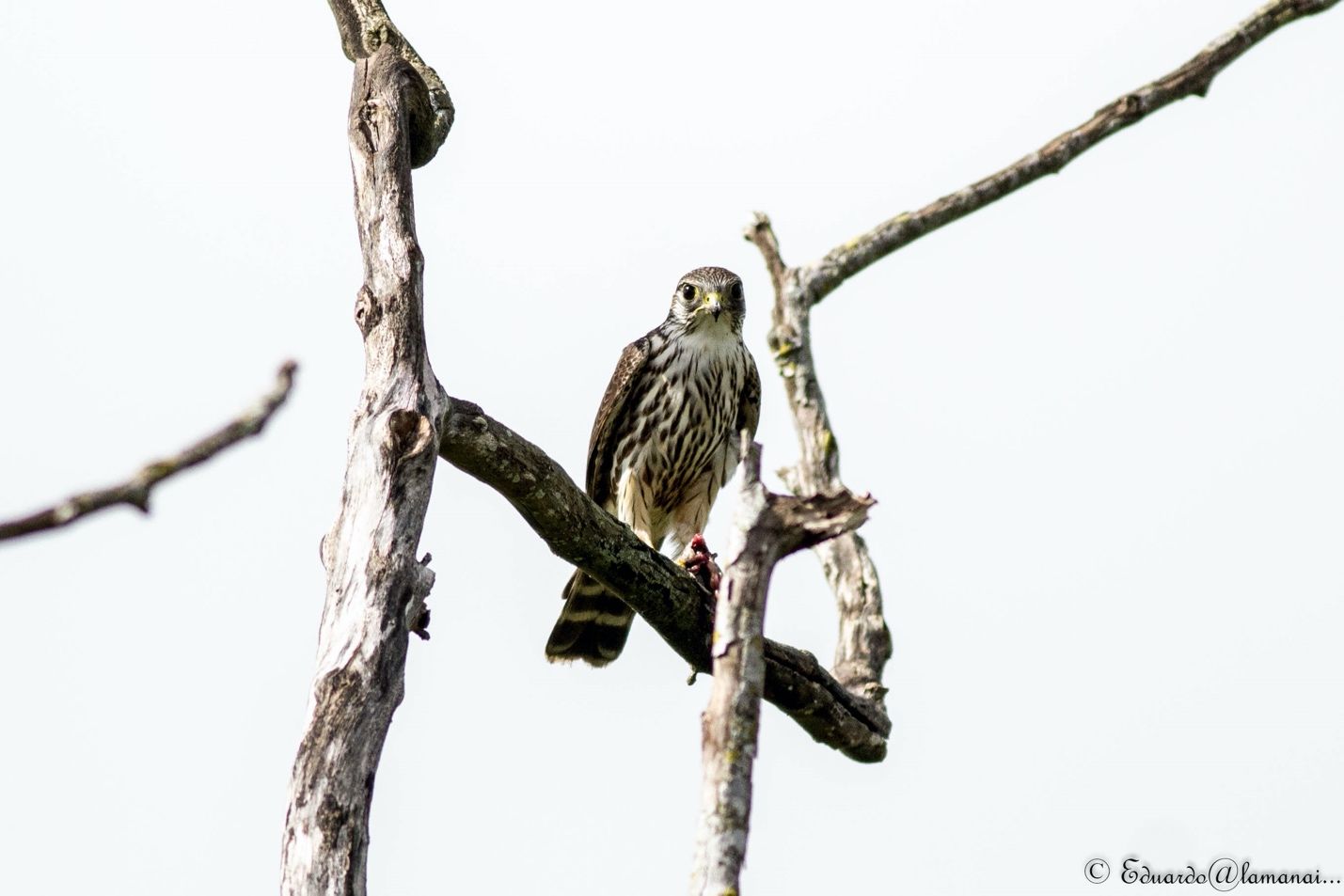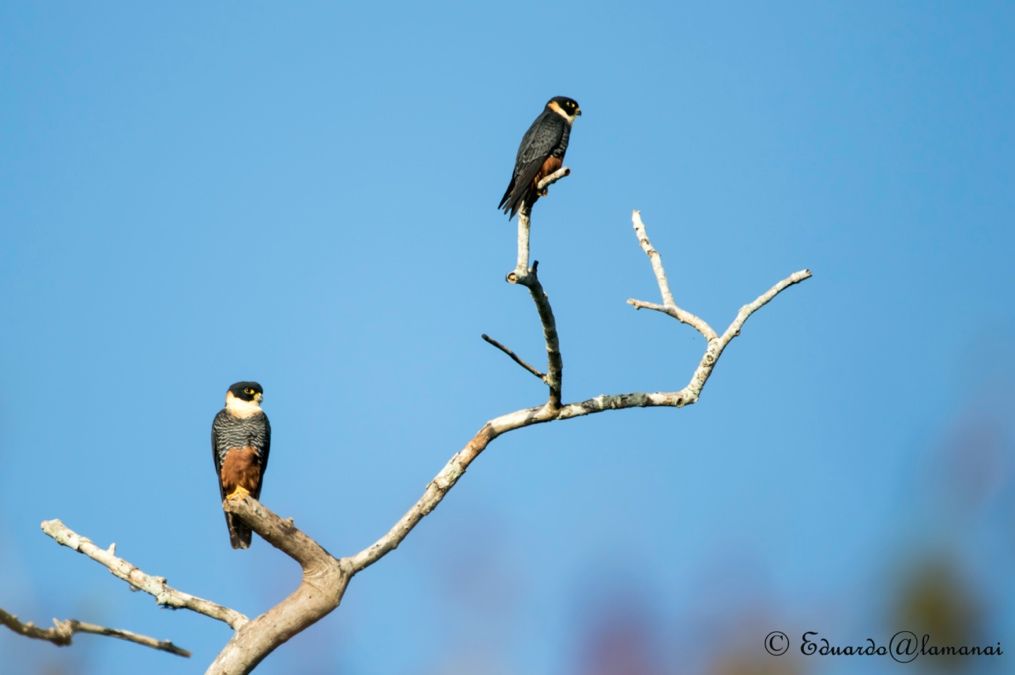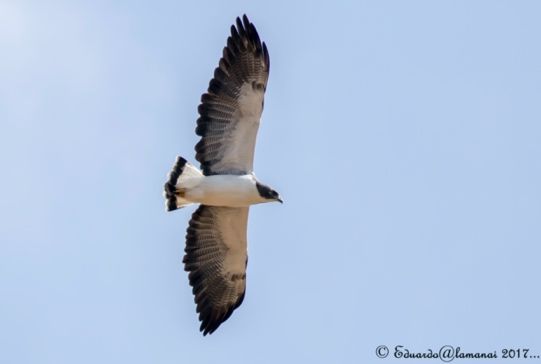
Credit: courtesy of Jorge E. Ruano
Introduction
Raptors and Belize
Belize has a wide diversity of habitat types, from the flat coastal plains to the Maya Mountains to dense old growth forests and lagoons teeming with life. More than 500 species of birds visit or live in Belize, and, because of its location, Northern Belize serves as an important stop-over point and attracts a large majority of migratory birds in addition to its year-round residents.
This guide showcases the top 10 raptor species (predatory birds) that you are most likely to encounter while in Northern Belize. It describes hawks, kites, eagles, and owls. Raptors can be found inhabiting all the various habitat types of Belize. They share similar characteristics, such as powerful talons and hooked bills, which aid them in the capture and consumption of prey. However, they differ in size and body shape based on their preferred hunting techniques and locales. Longer wingspans help conserve energy while raptors search for food over open plains and savannahs; elongated tails and shorter wings increase maneuverability when they hunt in dense forests. Special noise-dampening feathers and expert night vision give the ambush hunter an edge over prey ever on the alert ready to make a quick escape.
Unique characteristics to look for while bird watching include body size (LT), wingspan (WS), coloration, distinguishing markings, and flight style. Knowledge of habitat types and familiarity with birds’ unique call types help with identification as well. Your local guide is familiar with all the tricks and tips and will be your best resource when searching for elusive birds.
Barn Owl
Tyto alba, LT 15 in, WS 49 in.

Credit: courtesy of Jorge E. Ruano
This medium sized owl is pale buff, grey, and white with a disproportionately large head that gives it a top-heavy appearance. The Barn Owl has dark eyes set within a white heart-shaped facial disk. It is often seen in urban communities, agricultural areas, and quarries.
Merlin
Falco columbarius, LT 11.5 in, WS 26.5 in.

Credit: courtesy of Jorge E. Ruano
One of the smaller raptors characterized by a slate gray back and a black tail with 2–3 light gray bands. Its breast is light brown and striped, and it has a dark teardrop shape below the eyes. It flies swiftly yet purposely and never hovers. The Merlin can be found in Belize from mid-September to early May. Both sexes give a shrill, chattering call that can last 4 seconds.
Snail Kite
Rostrhamus sociabilis, LT 19 in, WS 44 in.

Credit: courtesy of Jorge E. Ruano
Identified by its delicate hooked beak and a distinctive white bar across the base of the tail, which is most visible during flight. Females are a blackish brown color, while males are a dark slate grey and are found in lagoons, freshwater marshes, and rice fields. There are two call types: a very raspy and nasal anh, given singly or repeated, and slow, raspy a-a-a-a-anh with a frog or insect-like quality. Northern Belize is one of the few places where this normally solitary raptor can be seen in small flocks.
Bat Falcon
Falco rufigularis, LT 10 in, WS 26.5 in.

Credit: courtesy of Jorge E. Ruano
The smallest of the top 10 raptors. Dark with a white throat that extends to a partial collar, a barred black and white breast, and a brown lower belly and thighs. They can be found in most habitat types including urban landscapes. Their call is a rapid kea kea kea kea kea kea kea.
Roadside Hawk
Buteo magnirostris, LT 14.5 in, WS 29 in.

Credit: courtesy of Jorge E. Ruano
These hawks have a gray head with a gray and brown streaked throat and breast, lighter brown bars on the belly and thighs, and a grayish tail marked by 4–5 black bars. They can be found in broken woodland and forest edges. Their calls range from a shrill eeeeeeeahhh, or cree cree cree to a “laughing” anh anh anh; and a softer heh ha heh ha heh ha.
Peregrine Falcon
Falco peregrinus, LT 17.5 in, WS 42.5 in.

Credit: courtesy of Jorge E. Ruano
An impressive bird with a distinctive broad “tear-drop” and a white slash on its face. Peregrines are often found in open areas on exposed perches and frequently seen near water. They have a squealy criii and whee-check cry.
White-tailed Hawk
Buteo albicaudatus, LT 21 in, WS 51.5 in.

Credit: courtesy of Jorge E. Ruano
This hawk has a white underside, a grey back with light brown bars across the shoulders, and a single, distinctive black tail stripe. Its long wings taper to a sharp point, and it is often found in open country, primarily savannas and pasturelands. Its call is a high-pitched laughing kureee k-hek k-hek k-hek.
Swallow-tailed Kite
Elanoides forficatus, LT 23 in, WS 49.5 in.

Credit: courtesy of Jorge E. Ruano
Striking black and white plumage pattern and a deeply forked tail. A graceful flier with slow, methodical wing-beats, it soars through open broadleaf and pine forests. Often found in upland areas. It vocalizes with several sharp cries of k-lee! or kree!
Gray-headed Kite
Leptodon cayanensis, LT 19.5 in, WS 39 in.

Credit: courtesy of Jorge E. Ruano
This large raptor has a dark, brownish-grey back with a pale grey head, a white underside, and a black tail marked by three thin grey bands. It is typically found along forested river edges and occasionally in more heavily forested areas. It gives a strong, catlike call: a three-toned raowwww, e-raaooouu, eee-yow.
Plumbeous Kite
Ictinia plumbea, LT 14 in, WS 35 in.

Credit: courtesy of Jorge E. Ruano
With a uniform gray back and a mottled greyish-white belly, Plumbeous Kites are distinguishable by their striking red eyes and elegant, pointed wings. When folded, the wings extend past the tail. They are swift predators that take prey in the air. They prefer open forests or savannahs. Their call is a rapid, ringing hee-h-h-h-he.
For More Information Contact
LAMANAI FIELD RESEARCH CENTER
Indian Church VillageOrange Walk, Belize
Tel: 011-501-678-9785
Email: info@lamanai.org
Reference
Jones, H. L. 2004. Birds of Belize. University of Texas Press, Austin, TX.
Footnotes
This document is one of a series of the Wildlife Ecology and Conservation Department, Florida Cooperative Extension Service, Institute of Food and Agricultural Sciences, University of Florida. Original publication date. Visit the EDIS website at http://edis.ifas.ufl.edu.
2. Elizabeth Scarlett, wildlife technician; Venetia S. Briggs-Gonzalez, senior research ecologist; and Justin R. Dalaba, science writer and outreach coordinator; UF/IFAS Fort Lauderdale Research and Education Center; Jorge E. Ruano, Belize bird guide and Lamanai naturalist; and Frank J. Mazzotti, professor; UF/IFAS Fort Lauderdale Research and Education Center, Institute of Food and Agricultural Sciences, University of Florida.
The Institute of Food and Agricultural Sciences (IFAS) is an Equal Opportunity Institution authorized to provide research, educational information and other services only to individuals and institutions that function with non-discrimination with respect to race, creed, color, religion, age, disability, sex, sexual orientation, marital status, national origin, political opinions or affiliations. For more information on obtaining other extension publications, contact your county Cooperative Extension service. U.S. Department of Agriculture, Cooperative Extension Service, University of Florida, IFAS, Florida A. & M. University Cooperative Extension Program, and Boards of County Commissioners Cooperating. Millie Ferrer-Chancy, Interim Dean.
Copyright Information
This document is copyrighted by the University of Florida, Institute of Food and Agricultural Sciences (UF/IFAS) for the people of the State of Florida. UF/IFAS retains all rights under all conventions, but permits free reproduction by all agents and offices of the Cooperative Extension Service and the people of the State of Florida. Permission is granted to others to use these materials in part or in full for educational purposes, provided that full credit is given to the UF/IFAS, citing the publication, its source, and date of publication.